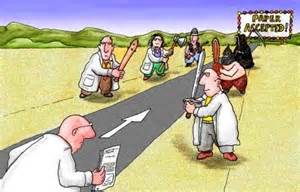(Part 3 of the triology)(August 17th)
Maybe you feel just like our genius from part 2 from the trilogy, two weeks ago. You work until you have developed a machine or technique that is able to take you one step further than what your bare eye can see, like a microscope.
Yet what if you DIDN’t know that such an instrument as the microscope exists?
What if you DIDN’T know that there is a technique that allows you to see beyond the resolution of a magnifying glass?
Yet what if the microscope has not yet been invented?
How would you come to a better understanding of your sample then?
Or would you even bother to look for ways to improve your understanding, unaware of that you only see a limited picture of the life forms that actually are present in your sample by the method you presently use?
Academic ethics, integrity of science, corporate ethics –“peer review”
It is the same with science: if science is unaware of that things exist that are not yet proven, and if no curious genius designs a machine to prove the things he considers might probably exist, how can he prove that they in fact do exist? This is the dilemma of science and always has been: it is only as accurate as the equipment it has at its disposal.
Therefore, the experiment of our curious genius trying to prove his wild advanced theories using only available equipment might as well fail to yield a positive answer.
You simply won’t see bacteria with the bare eye.
Our genius could be satisfied with this, having tried to prove his idea in a scientifically sound manner. Or he might wonder on about what else he could try to prove his ‘gut feeling’. And eventually come up with a machine advanced and novel enough to prove his point right.
But this may take time, and until this new-invention-to-come yields first results that are reliable even more time will pass. So; how long will it take to get any of those results through the established scientific maze of criticism and into the public media? I hope I will live to tel (-;
 Future scientific work
Future scientific workToday, many of these machines which can reliably measure non-material processes still have to be developed. It is like we are working with our bare eyes, and some have a magnifying glass. The microscope to see the greater context is just being developed. And imagine what we will learn once the electron microscope-equivalent has been invented! I expect that we will gain amazing insights in many more and fascinating details about the workings of the universe, consciousness and alternative ways of healing within the next decades. And that we will be able to scientifically prove more of what is going on.
Progressive studies available today
Differences between classical and modern approach toSo we’ve come to the last part of this mini series on why it is so hard for science to prove the effects of alternative medicine techniques.
To date, there are more than 10.000 scientific papers dealing with the source field, consciousness and other ‘new’ paradigms/beliefs. A thorough overview of sound studies produced all over the world exceeds the aim of this series, and I, therefore, refer the interested reader to check out f.eg. the works of cutting edge scientists and visionaries like -David Wilcock, Bruce Lipton, Gregg Braden and others. You find some introductory literature at the bottom of this post.
Round-up
One of the main challenges of science to prove that new and alternative ways of helping people with physical, psychological and emotional problems is partly due to the fact that it takes time for scientific discoveries to manage to get through to and accepted by, a broader public. It can take several years if not decades before a new scientific discovery is being accepted by the scientific community. It takes years and decades after this acceptance for the new findings to make their way into literature, magazines, school books, and eventually become accepted, common knowledge.
Science has accepted that some occurrences we attribute to chance can, with more and more expensive measurements, be predicted. Just think of the weather. While we have perceived the world as a series of random accidents, the world is unfolding through underlying patterns we have yet to recognize. Future events can not only be predicted, but also influenced and responded to before they occur! This offers us more survivability and mastery over life.
Healing ourselves means to recognize what science is telling us about being co-creators of our life and environment, not helpless victims. Instead of remaining passive and depending on guidance, like children, who merely follow teachings, healing and conscious living involves becoming “adults” who actually question the teachings they receive during their lives and at the same time adopt new knowledge which they really and truly can agree with and live in harmony with.
Now we’ve reached the end of this trilogy about the dilemmas of science when trying to prove the workings of holistic medicine. I hope you have enjoyed it!
What did run through your mind when you read my argumentation?
Did you come across any eye-openers?
Please leave your most surprising insight in the comment box for others!
If you liked this article, mark the following date in your agenda:
’10 practical and fun tips for living with (high) sensitive children’ (August 31th)
My number 1 desire is to inform and inspire you. Sign up for my blog and you will be provided automatically with more insightful information and inspiring mind-travels.
Image credits 1, 2
References and further reading
Gregg Braden: The Spontaneous Healing of Belief
Rhonda Byrne: The PowerBruce Lipton: The Nature Of Dis-Ease
Lynn McTaggert: The Field
H.F. Nijhout (1990): Metaphors and the Role of Genes and Development
Eric Pearl: Heal others, Heal yourself
David Wilcock: The Source Field Investigations: The Hidden Science and Lost Civilizations Behind the 2012 Prophecies
